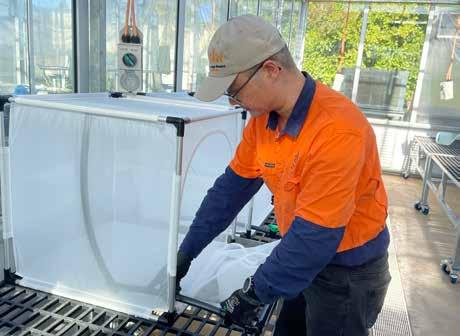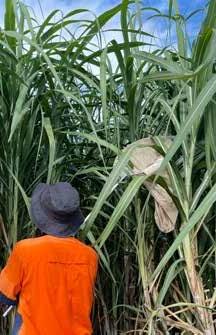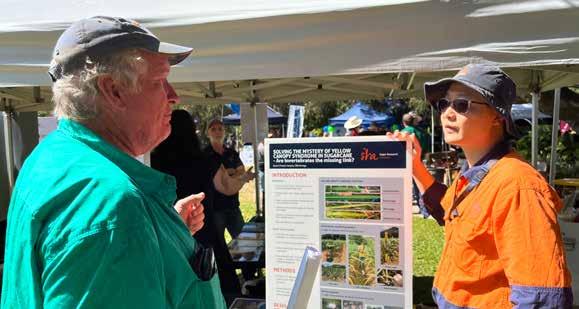
2 minute read
SOLVING THE MYSTERY OF YCS IN SUGARCANE - ARE INVERTEBRATES THE MISSING LINK?

Yellow Canopy Syndrome (YCS) was first observed in Australian sugarcane in 2012 in Cairns. It has since spread as far south as Maryborough.
Advertisement
YCS can impact cane in several ways. This can range from yellowing in the midcanopy region (leaves 3-7), accumulating carbohydrate starch in the leaves and shortening internodes.
Depending on the degree of symptom, crop growth can be compromised with potential impacts on final yields. Growers have reported YCS symptoms that ‘come and go’ in waves through the season.
Sugar Research Australia continues to invest in research to fully understand what causes YCS and how it may be managed. Current work is focusing on the potential association between invertebrates and YCS.
Hang (Hank) Xu is in the third and final year of his PhD. He is based at SRA’s
Meringa research station working under the supervision of SRA Entomology Leader, Dr Kevin Powell, and Professor Gavin Ash and Dr Bree Wilson and Dr Jacob Humpal from the University of Southern Queensland (UniSQ), Toowoomba.
Previous research studies have identified that YCS does not appear to be due to pathogens or nutrient deficiency. However, it is influenced by weather conditions and some insecticides under experimental conditions reduce YCS expression.
“Once we identify the cause of YCS, we can start to investigate what on-farm management strategies we could use to monitor and effectively treat the syndrome,” Dr Powell said.
Hank’s research topic - Advancing Techniques for Diagnosis of Yellow Canopy Syndrome - is investigating if invertebrates are the missing link.
“I began this research in January 2021. I am specifically looking at the role that invertebrates (which include insects and mites) may play in YCS and hoping to narrow down which group of invertebrates may be associated with the syndrome.
“I will then develop a molecular-based diagnostic tool for early detection of the target species, or multiple species, in the field and a remote sensing based method for YCS symptom surveillance,” Hank said.
Working with Dr Powell and the entomology team in Meringa, Hank initially identified 10 invertebrate groups representing multiple species that are found in YCS-affected cane fields. Utilising a range of trapping methods, he monitored these groups over two seasons and gathered hundreds of samples for identification.
Hank has now narrowed down his research focus to three invertebrate groups: mealybugs, mites and whiteflies.
Through an ongoing monitoring program, including glasshouse trials at the University of Southern Queensland (UniSQ) in Toowoomba, Hank is now hoping to validate if one or more of these invertebrates are involved in YCS.
“The first two years of the research involved detailed seasonal studies in cane fields at Aloomba, FNQ. Additional trapping was undertaken in collaboration with SRA Industry Service staff and growers in Ingham, Mackay and the Burdekin,” Hank said.


“This took time and a great deal of effort, as we know from previous research that YCS is inconsistent depending on the season. But now we’re able to start the next phase of the project which focuses on detection.
“This year I will introduce these three invertebrate species to sugarcane I have grown from seedlings in the Toowoomba glass houses, to try and induce YCS under experimental conditions.
“I have also started a pilot study to be able to detect the invertebrates using molecular techniques and at the same time detect YCS yellowing through remote sensing techniques.”
Until now YCS has only been detected by eye, and it can appear one day and disappear the next.
“If we know what invertebrate causes the YCS, we can develop a molecular test to identify it early.
“If the yellowing can be picked up early using remote sensing that will be another good detection tool,” Hank said.
And this will mean an early warning system for growers.










